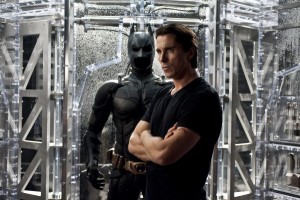The final chapter of celebrated director Christopher Nolan’s Batman trilogy is lengthy, dense, and difficult to characterize with broad strokes. The film is fraught with distracting, silly, problematic elements, but it also presents some thrilling setpieces and takes the Batman character to some unexpected places. Ultimately, one’s potential enjoyment of the film comes down to whether the film’s significant flaws are forgivable when weighed against its bright spots.
First, the bad news, starting with the film’s central villain, Bane (Tom Hardy). This masked thug is physically imposing and does manage to best Batman in single combat, but his motivations are muddled and inconsistent. Bane presents himself as a revolutionary figure who wishes to return control of Gotham City to its people, when in reality he is holding them all hostage with a nuclear bomb.
The bald political moralizing from Bane (and, to a lesser extent, Anne Hathaway’s Catwoman/Selina Kyle) seems hokey and misplaced. Further, Bane’s oddly goofy voice (imagine a bored Sean Connery playing Snidely Whiplash from the bottom of a well) considerably undercuts the character’s potential menace. As a comic book character, Bane is a relic of an unfortunate trend toward extreme edginess in 1990s comics (Bane is best known as the figure who broke Bruce Wayne’s back in the 1993 “Knightfall” story arc), and hasn’t been matured or developed enough to fit with the otherwise realistic backdrop of the Nolanverse version of Gotham.

There are other issues as well, and many of them represent an unfortunate magnification of some ofthe flaws of the previous entry in the series. At 165 minutes, the film is bloated with subplots and characters that we just don’t need. The most glaring is Catwoman, and her quest for a magical piece of software that can erase her existence from every database on earth. Her backstory is flimsy, her motivation is never explicated, and she isn’t half as sultry and mysterious as the script wants us to think. A similar problem arises when Bane (as in the comic book) injures Batman’s back and then sends him to an underground prison a continent away.
This is problematic for a multitude of reasons. First, Bruce Wayne’s spinal injury is repaired with nothing more than a smack to the lumbar and a few sit-ups, making his brief recovery and return both unearned and undramatic. Then, once he has made it back to Gotham, Bane expresses shock and disbelief in a tired and all-too-predictable villainous miscalculation. This is especially clumsy when we learn that Bane and his secret accomplice (revealed in a late twist that required far too much dialogue to explain and had far too little dramatic impact) planned to blow up the city all along. That they wait until Batman gathers allies and repositions himself to disrupt their plans seems impossibly dumb, even by the low standards set by your average comic book movie fare.
Further, one can’t help but be impressed by Nolan’s courage in taking away so much from Bruce Wayne and Batman, even if it leaves “The Dark Knight Rises” seeming overwhelmingly downbeat overall. The plot holes, glaring as they are, as easy to overlook when we’re forced to move so quickly to keep up. As the definitive ending to his trilogy, Nolan also did a fine job of tying the three films together and resolving everything satisfactorily. Though imperfect, this trilogy represents the most thoughtful and well-realized adaptation of any comic book property, and it may be a long time before Nolan’s work is surpassed.
If you’re a fan, then live it up while you can, because the Batman film franchise is so profitable, the inevitable reboot has already been greenlighted. If you enjoyed the first two films, have an attention span exceeding two and a half hours, and aren’t too picky about plot holes or cartoony villains, you’ll probably love “The Dark Knight Rises”. If you’ve never enjoyed a comic book movie or actions film, nothing about “The Dark Knight Rises” is likely to win you over.
– by Demian Morrisroe